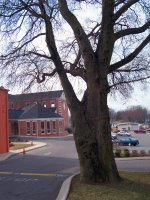Hackberries in Hopkinsville (and beyond)
 This big hackberry tree grows on the grounds of St. Peter & Paul Catholic Church in Hopkinsville. It is actually two hackberries that sprang up side by side and finally grew into each other. The trunk and branches of both parts of the merged tree are distorted from the struggle they have endured and the tree is scarred from severe pruning to eliminate conflicting branches. It's too bad that someone didn't intervene when the trees were young. It is a big tree that makes plenty of shade, but it is not the beautiful tree it could have been if one seedling had been eliminated.
This big hackberry tree grows on the grounds of St. Peter & Paul Catholic Church in Hopkinsville. It is actually two hackberries that sprang up side by side and finally grew into each other. The trunk and branches of both parts of the merged tree are distorted from the struggle they have endured and the tree is scarred from severe pruning to eliminate conflicting branches. It's too bad that someone didn't intervene when the trees were young. It is a big tree that makes plenty of shade, but it is not the beautiful tree it could have been if one seedling had been eliminated.One of the largest trees I have ever seen in Hopkinsville was a hackberry. It grew on the east side of town, about a block from Highway 68/80 in a low place. I guessed its age at 150-200 years or even more, based on its impressive height, breadth, and girth. I was horrified one day to see that it was being cut down. It lay on the ground for a year; then finally they burned it and built a duplex where it had been. I wish I had taken its picture while it was still a beautiful giant.
I saw a hackberry tree yesterday somewhere along south Main Street when I was taking my walk. You can also see a few big hackberry trees in the Jefferson Davis State Park at Fairview.
 Hackberries are easy to identify even in winter because of the texture of their bark. It is nearly as smooth as a beech, except for its warts. Some hackberries have more warts than others. Here's a closer look at the bark (and also the leaves) of the hackberry at the Catholic church last July.
Hackberries are easy to identify even in winter because of the texture of their bark. It is nearly as smooth as a beech, except for its warts. Some hackberries have more warts than others. Here's a closer look at the bark (and also the leaves) of the hackberry at the Catholic church last July.Hackberry trees have little purple-brown berries in the fall that are enjoyed greatly by birds, squirrels, and other small mammals. They are fast growing trees and they don't usually suffer much wind or ice damage, but they are susceptible to some insects and certain tree diseases and disorders.
In southern Kentucky, we're at the southern end of the hackberry's natural range. It is a native as far north as North Dakota and Maine in the U.S., though not to all localities between those two states. The hackberry's range extends into southern Canada as well.
I don't think we had any hackberry trees on the ranch in Nebraska where I grew up, but I have seen old photographs of "hackberry pockets" in the Sandhills (see 5 and 6 here.) Under the semi-arid conditions of the Sandhills, the hackberry appears to be a much smaller tree. We get three times more rain per year in Kentucky than northern Nebraska does. That has surely been a factor in the growth of the big hackberry trees that we see around Hopkinsville and Christian County.
No comments:
Post a Comment